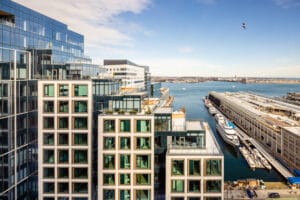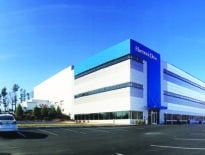
Tiered private terraces at EchelonSeaport in Boston reflect the high priority that developers of luxury multifamily projects placed on outdoor space even prior to the pandemic. Photo courtesy of CBT Architects
The traditional cornerstones of luxury living are undergoing a dramatic evolution as people’s collective quest for health, wellness and connection reach a fever pitch in 2021.
As designers of multifamily buildings that span all lifestyles, we have the responsibility to understand and interpret the changing needs of all residents who inhabit the environments that we create. While this has always been the case, the last year-and-a-half has presented a faster pace of change than we have ever seen.
Luxury living in particular has seen some of the most interesting pivots concerning how we conceive buildings, shared spaces, amenities and units. The socially hermetic luxury buildings that were emblematic of a certain lifestyle in years past have given way to ones that are suddenly throwing their doors open to the world around them. It is no longer about getting into the building and being spirited up to their units that these clients are seeking, but a more holistic and satisfying experience of arriving home.
Luxury Buildings Throw Open Doors
What does this look like? We are seeing a great desire in the luxury market for a more human experience in our urban high-rises – contrary to what we have seen in the past.
Luxury buildings are now being designed to blend into their environment. Wide-open ground-floor spaces that spill onto the sidewalk allow residents to be socially engaged with their neighborhoods without leaving home. These ground-floor spaces come in the form of dedicated cafes, coworking spaces and event spaces that incorporate the best in city living – the ultimate luxury.
For example, our superhybrid design at 176 Lincoln in Boston’s Allston neighborhood (a mix of residential, maker space, innovation space and destination retail) creates a sought-after lifestyle reflecting a fusion of apartments, workspaces and community-focused public realm.
In addition to being desirable amenities, the openness of these design elements naturally comes with fresh air, natural light, and social interaction. High porosity of luxury buildings today is an asset, and we are approaching their design in a way that leverages curated human connections.
Options Become the Amenity of Choice
This richness of daily experience carries beyond the ground plane to upper floors, as evidenced by the unique amenity packages we are designing today. Options for how to spend time within luxury buildings should be varied and creative, reflecting both traditional and aspirational lifestyles, as well as the changing palate of many of our higher-end clients. Offering a wide range of well-appointed spaces – and therefore lifestyle choices – responds to the growing diversity of residents in these buildings today.
For example, we weave multiple pools and amenity decks throughout our buildings, as well as spas, lounges and fireplaces. These spaces may include such amenities as WiFi where residents want and need it and sports simulation equipment – but also device-free spaces.
At one of our Boston projects, we are designing a speakeasy that will intentionally be free of hand-held devices to encourage human interaction. The space offers poker tables, a curated vinyl record collection and a collection of selected reading materials. These days, creativity and diversification of building offerings are keys to attracting a vibrant and engaged residential community at the luxury level.
Units Import Single-Family Perks
For years, it was logical for city living to be compact, which was great for the pied-a-terre lifestyles. However, with the necessary work-from-home era that was introduced to our daily lives, we have pivoted to rethink the in-unit living experience.
Previous design principles reflected a city-based luxury lifestyle that assumed many out-of-unit experiences. Think: restaurants, gyms, parks – all of which were either limited or eliminated from daily life when the pandemic arrived. In response, designers had to actively reimagine how people can get the most out of their unit to enrich the experiences that they seek.
We are now designing in a way that imports the quality of life in single-family homes into our unit planning within multifamily buildings. Important spaces of today’s luxury living – and all living – include such areas as dedicated mudroom zones and creative and flexible work-from-home space.
We have also seen more subtle changes in lifestyle expectations, the most notable of which being the demand for outdoor space. Balconies aren’t enough – we are talking about generous, tiered units that can provide grassy terraces and expansive patios for authentic outdoor experiences.

R. Vickie Alani
Many of our high-rise projects are designed now with a much greater ratio of outdoor vs. indoor space than ever, which equates to a marked desire by residents to get outdoors without leaving home. We designed such units for EchelonSeaport well before the global health crisis, and find that they are highly desirable for today’s luxury residential tenants.
Broadly, we are focusing on outdoor air, adequate storage space and appliances that are not “city-sized,” to accommodate well-rounded lifestyles.
It’s not certain that we’ll see these evolutions as permanent changes in the way multi-unit luxury housing is conceived; it is sure to be another lesson that only time will tell, as we continue to study and rethink the future of living in the city. What we can say is that this time has brought forth a renewed focus on our connection to others, which will undoubtedly drive design strategies for years to come.
R. Vickie Alani AIA is a principal at CBT Architects.






